Last Updated on November 19, 2023 by Masha Eretnova
Art supplies stores stock various paints, brushes, canvas, and other materials for budding artists. As you may have seen, poster paints are less expensive than acrylic paints. Is it worth it? However, debating between poster paint vs acrylic paint, which one is the best for painting with family, crafts, or professional art?
Acrylics are more professional and durable than poster paint. Poster paint is affordable matte paint for school projects and kids’ paintings. It is water-based as acrylic paint but dries faster and is only used on paper. Acrylic paint is great for beginners and advanced artists working on different surfaces and techniques.

For beginners in painting, the question of what supplies to use can be daunting. Two of the popular paint types are acrylic and poster paint. So, what’s the difference? In this post, we’ll look at the pros and cons of each type of paint and help you decide which is right for you.
Table of content:
- What is Poster Paint?
- What is Acrylic Paint?
- Which is better, acrylic or poster paint?
- Is acrylic and poster paint the same?
- TABLE: What is the difference between poster paint and acrylic paint?
- Consistency, drying time, durability, colors and more aspects compared
- What are Poster Paints Used For?
- Can I Mix Poster Paint And Acrylic Paint?
- Can I Use Poster Paint Instead Of Acrylic Paint?
- Will Poster Paint Work On Canvas?
Hi! I’m Masha! My blog is supported by affiliate programs. It means no extra cost for you but a little commission for me. Thank you for your support!
What Is Poster Paint?
Poster paint is an opaque water-based, inexpensive paint made of a glue-based binder and a rich pigment. This type of paint was specifically designed for use on posters and papers to get bright, vibrant colors. It dries faster than acrylics to a matte, chalk-like finish, but poster paint is not permanent.
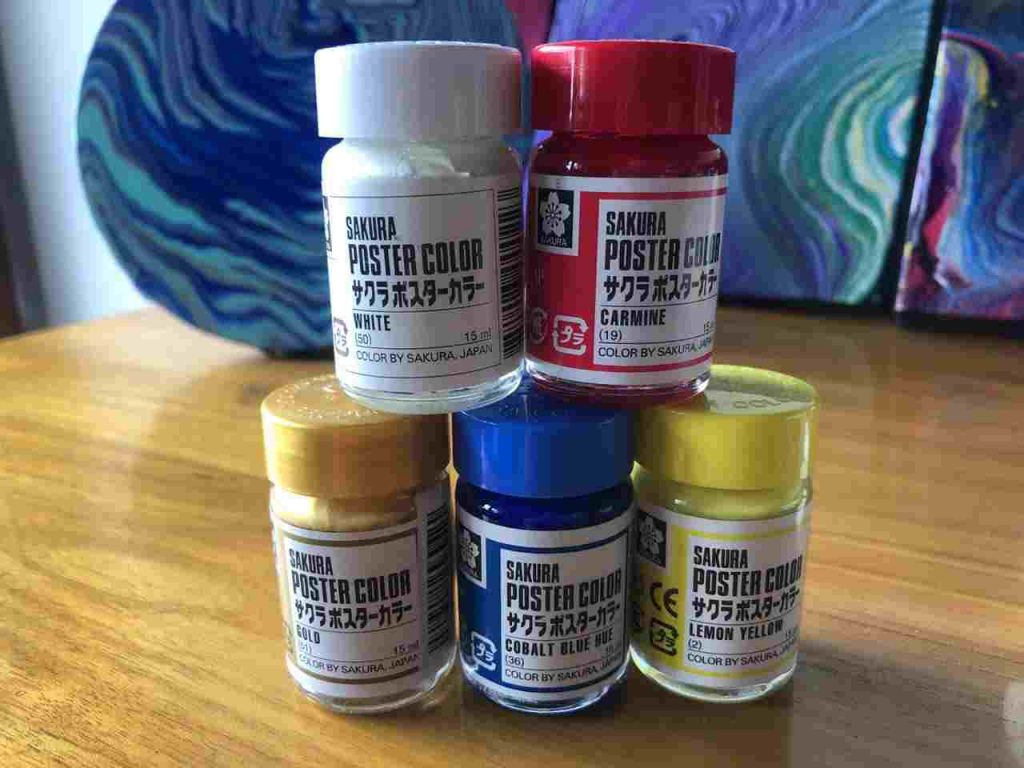
It comes in liquid or powder form, often in jars, and can be diluted with water before painting. While painting and even after drying, you can still reactivate poster paint with a little bit of water, unlike acrylics that are water-resistant once dried. A nice bonus for parents and schools – most poster paints are easily washable!
Best of all, poster paint is relatively inexpensive and easy to find, making it an excellent option for crafters on a budget – a perfect find for finger painting!
Is poster and tempera paint the same?
Poster paint is often called inexpensive tempera paint, which is not technically true. In the US, they are pretty much synonyms, but tempera has a food-safe protein-based binder, while Poster paint has a glue-based binder (can be cellulose, gum-water, starch, or Cornstarch).
Washable tempera is also called poster paint, which is closer to the truth as normally these washable temperas have nothing in common with traditional egg tempera and are cheap and kids-friendly.
Related: Tempera Vs Acrylic Paint: What Are The Differences?
Diluted with water, poster paint can act as watercolors staining the paper.
Crafters and parents believe the best poster paint is Crafty Dab, Creative Deco, and Crayola Washable paints.
What are Acrylic Paints?
Acrylic paints are water-based paints containing pigment suspended in a polymer emulsion. Acrylic paints are fast-drying, durable, and flexible, making them ideal for various surfaces and applications.
They can be used on anything from canvas to ceramic floors and are perfect for indoor and outdoor projects. Acrylic paint is also one of the most versatile mediums available to artists, crafters, and DIY enthusiasts.
You can use it for various techniques, including painting, glazing, staining, and more.
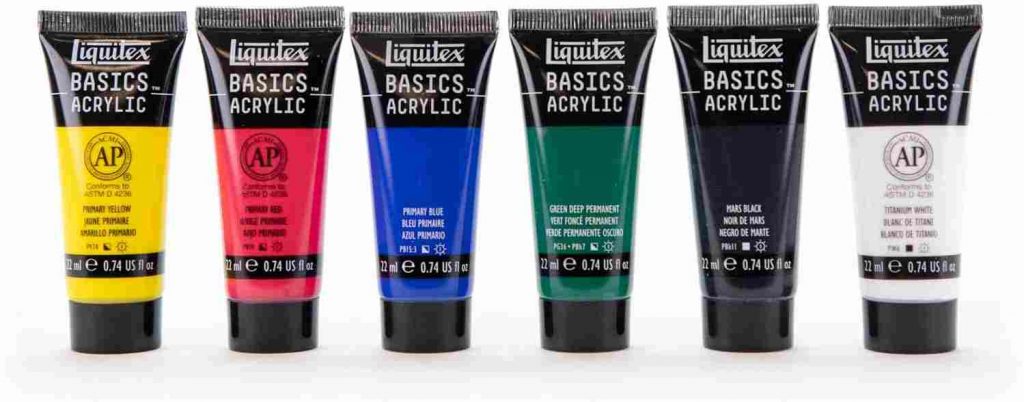
Acrylic paints are water-soluble but become insoluble and water-resistant when dry.
Depending on how much the paint is diluted with water or modified with acrylic gels, media, or pastes, the finished acrylic painting can resemble a watercolor, a gouache, or an oil painting and has its unique characteristics not attainable with any other media.
The binder used in acrylic emulsions makes this type of paint more flexible than oil paint (and less smelly). But once acrylic dries, and you can not further manipulate it. It is also possible to add beads or other acrylic ,ediums to wet paint to give it extra texture.
Which Is Better, Acrylic Or Poster Paint?
Acrylic paint and poster paint are both water-based, opaque, water-soluble paints. Both are good for painting on paper or poster board.
Acrylic paint is an excellent choice for beginners and professional artists. If you are looking for durable and versatile paint that dries quickly and works on canvas, paper, wood, glass, and many other surfaces, acrylic paint is a good option. For painting as a hobby or a profession – acrylic paint is better.
Poster paint offers a nice matte finish and opaque colors. Poster paint will be great for small craft projects that are not meant to last: easy painting with kids on paper or poster board. A big advantage for parents is – poster paint is very affordable.
For this article, I bought and will be using to test poster paint vs acrylic: Sakura Poster Colour vs Winsor & Newton Galeria Acrylic paint
Are Poster And Acrylic The Same?
Even though both poster paint and acrylic paint are water-based, easy for beginners to use, and dry quickly, they are not the same. Acrylic paint is polymer-based paint that dries quickly and becomes water-resistant when dry.
Poster paint, on the other hand, is a type of water-based paint made of glue or Arabic gum binder and is not as durable and dries more slowly.
Acrylic paint is often used for crafts and artwork because it can be easily mixed and blended to create different colors and effects. Poster paint is more commonly used for school projects or Signs since it is less expensive and easier to clean up.
Acrylic paint generally provides a more consistent color than poster paint, but it is less forgiving when it comes to mistakes.
What Is The Difference Between Acrylic And Poster Paint?
Both acrylic paint and poster paint are popular mediums for creating art. We’ll look at the differences between poster paint and acrylic paint, so you can decide which is right for you.
| Aspect | Acrylic Paint | Poster Paint |
| Paint composition | Water-based paint with polymer binder and pigments | Water-soluble paint with glue-based binder and pigments |
| Consistency | It can be creamy, liquid, soft, or heavy body. | Liquid (creamy) or powder |
| Dry time | Dries to touch very quickly, usually within 10-20 minutes. Fully cured within 24 hrs | It can take up to an hour to dry |
| Opacity | Greater opacity | More transparent and light |
| Preparation | No prep painting on paper. Canvas, wood, glass, etc. require priming | can be used without priming |
| Price | More expensive than poster paint, ex. Liquitex acrylics set of 12 colors is around $30 | Budget-friendly.Ex., Crayola paints are only $5 |
| Painting surfaces | 10+ surfaces: canvases, wood, paper, glass, plastic, metal, etc. Not safe for the skin | papers or cardboard, paper-mache, finger painting |
| Mixing and blending colors | can be mixed and blended to create new colors | colors tend to stay separate when mixed |
| Layering and available techniques | More than 20 techniques, including glazing, misting, pouring, and impasto | has a softer consistency, can’t be durable when it comes to art techniques |
| Color lifting | resistant | non-resistant |
| Finish | glossy | matte |
| Durability | more durable Shelf life up to 10 years | less stable Shelf life 2-3 years |
| Toxicity and Safety | Modern formulas are non-toxic but not safe for skin or to swallow | less harmful and safe to use by kids |
| Water resistance | Water-resistant once dry | Washable |
| Mediums and add-ons | Variety of mediums: gels for impasto, fabric mediums to paint clothes, pouring mediums, etc | can be easily mixed with glitter or other add-ons to create unique effects. |
This article was of some help to you in understanding the difference between acrylic and poster paints. If you have any questions or need clarification on anything, feel free to reach out to me. I would love to hear about your experiences with these two types of paints, especially if you’ve tried using them for a project. Which kind of paint do you prefer? Have you had better results with one over the other? To give you more information about the aspects shown above, keep reading!
Paint Composition
Acrylic and poster paints are water-based but differ in composition. Acrylic paint is made from acrylic polymer and additives, and some pigments can be toxic, while poster paint generally contains glue or casein and is less hazardous. Both paints contain pigments, but acrylic paint has stronger pigments that are more lightfast (don’t fade over time).
Poster paint dries to a chalky finish but is washable and will be ruined by water due to its composition. Acrylic paint’s composition allows durability, greater coverage, and better performance on multiple surfaces.
My test: Even after painting, poster paint is easily washable with just a paper towel and water:
Consistency
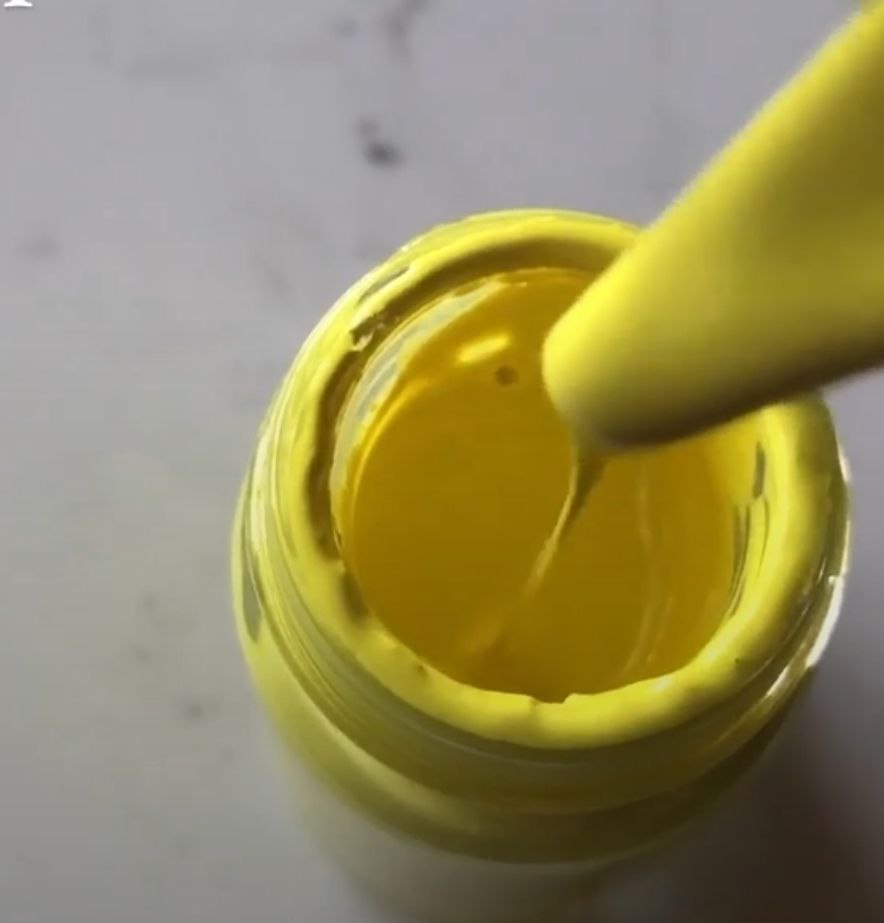
Different ratios between acrylic polymer binder, pigments, and additives make soft or heavy body (very thick) acrylics and even fluid acrylic paint for pouring. While poster paint is mainly powder mixed with water and cannot have different “bodies” or thicknesses.
Soft body acrylics have a creamy consistency, while the heavy body is very thick, close to oil paints. For me, poster paint consistency is very much like gouache paint – creamy, easy to flow.
My test: I feel like poster paint is more inconsistent in its consistency (I’m sorry) from bottle to bottle than acrylics. I had red color completely hardened that I needed to soften it with water, while yellow was almost too runny:
Poster Paint vs Acrylic Paint: Dry time
Acrylic dries fast – within 10-30 minutes, it will dry to the touch. But to be fully cured, an acrylic painting needs 24 hours. Poster paint takes longer to dry, up to 1 hr., but you can speed it up with a hairdryer if needed.
Acrylic paint also doesn’t fade or chip as easily as poster paint, which makes it a good choice for paintings that will be on display for a long time.
Opacity
Both acrylic and poster paint are considered opaque, especially if compared to watercolor. But acrylics look darker once dry and slightly more opaque than posters, I believe, due to this chalky composition of poster paint.
The opacity of the poster paint sometimes depends on how well you load your brush, for ex., here I tried to mix poster paint with water and do it with a rather dry brush and you can see the difference in opacity (W = water, TW =
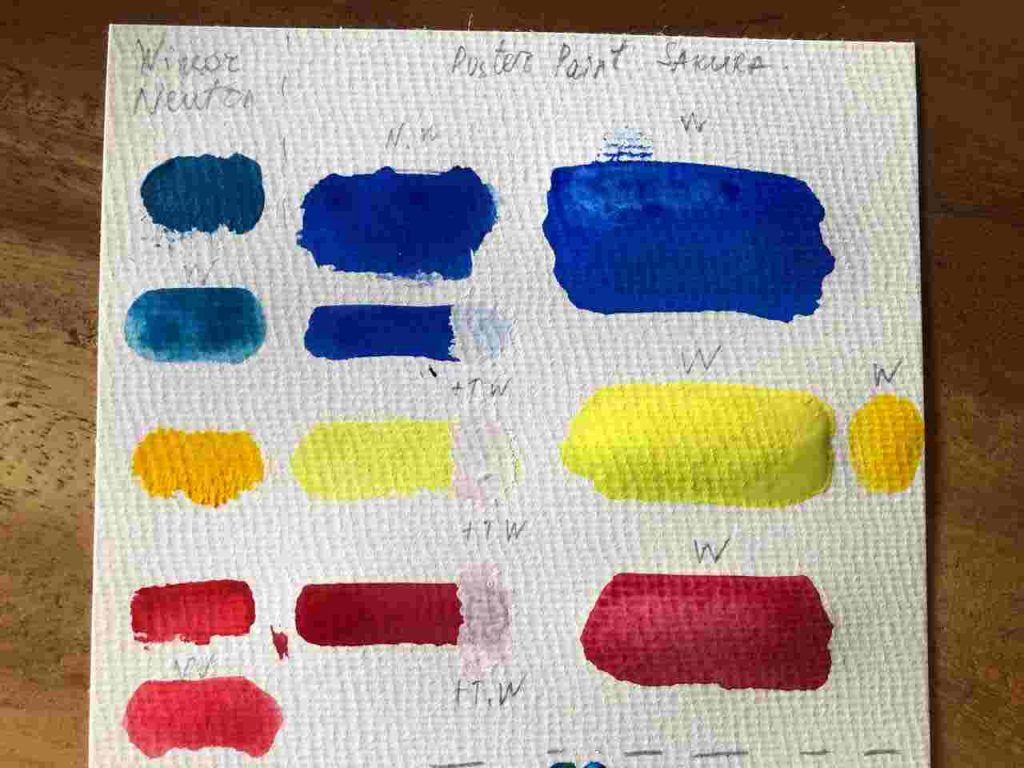
Preparation
Acrylic paint requires more preparation than poster paint. If you paint on a canvas or wooden panel, you’ll need to use a primer – gesso – before painting with acrylics, whereas you can usually start painting directly on the paper with poster paint.
If you work with poster paint, it is recommended to thin it lightly with water. With acrylics, you can use water or mediums as well.
Poster Paint vs Acrylic Paint: Price
Acrylic paint is more expensive than poster paint but is more durable and produces a more professional finish. For these reasons, acrylic paint is the preferred choice for artists and serious hobbyists. However, poster paint is suitable for children or anyone looking for cheap, easy-to-use paint, as you can buy a set of 6 to 10 colors starting from $5!
Painting Surfaces
Acrylic paint can be used on various painting surfaces, including canvas, wood, fabric, glass, plastic, ceramics, and metal.

Poster paint is more limited in this regard and is typically only used on paper or cardboard.
When applied to a surface, acrylic paint dries quickly and has a smooth finish. Poster paint takes longer to dry and often leaves behind a rougher chalkier texture. Finally, acrylic paint is available in a broader range of colors than poster paint.
Mixing And Blending Colors
Acrylic paint can also be combined with other acrylics to create different colors and shades, while poster paint will separate if mixed. Mixing or blending is not really possible with poster paint – it will get muddy.

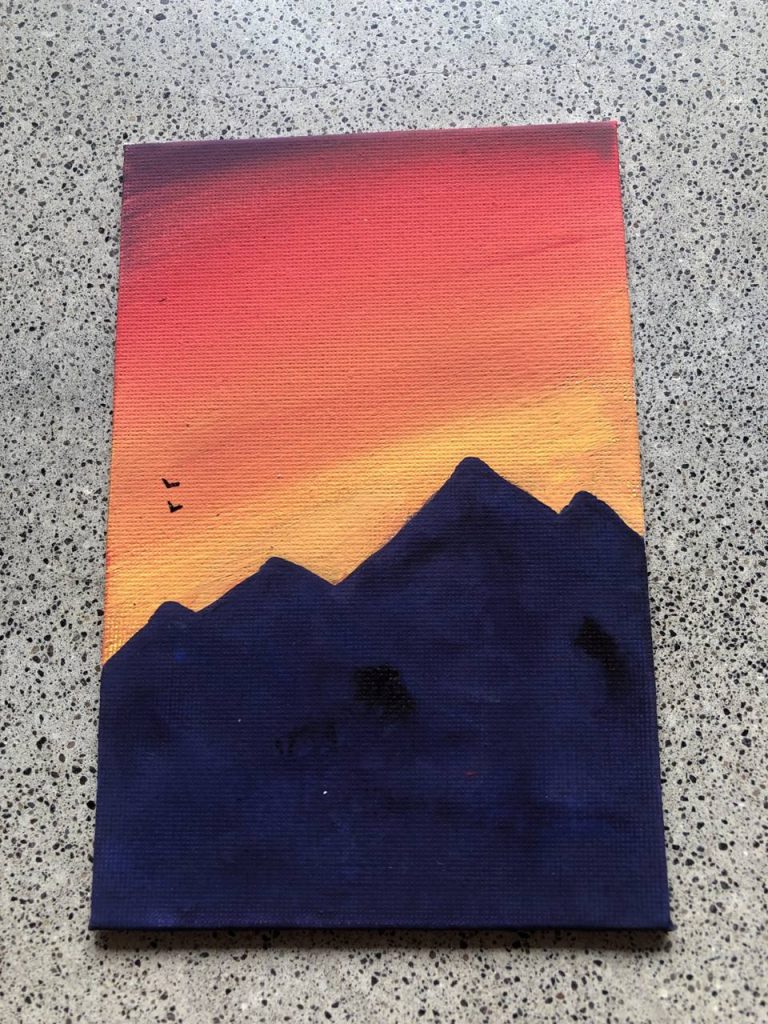
But blending with acrylics, you will create beautiful gradients, backgrounds, and sky colors in your paintings.
However, I managed to create a nice sunset with just poster paints on a small canvas board:
Layering And Available Techniques
The best approach for acrylic painting is to paint with thin layers, which is possible with acrylics. Acrylic paint can be used for various techniques, including glazing, misting, and impasto. Acrylic pouring is one of the most popular techniques as it creates stunning abstract paintings!
Unlike acrylic paint, poster paint is not suitable for layering, glazing, or misting techniques. However, you can use it just to paint with kids.
Color Lifting
Color lifting is more common for watercolor paint and can be done with poster paint, as it is not water-resistant when dries. If you paint with poster paint, even when it dries, you can still make colors lighter with a little bit of water.
With acrylics, such a trick won’t work. Once it’s dried, the paint forms a water-resistant film and can not be dissolved with water again.
If you need to create some paint washes, it is better to work with watercolor or slow-drying acrylics.
Poster Paint vs Acrylic Paint: Finish
Acrylic paint dries quickly and has a more glossy finish, while poster paint dries slowly and has a matte finish. In addition, acrylic paint is more durable and resistant to chipping, while poster paint is more prone to damage.
Acrylic paint is available in many colors, while poster paint is usually only available in primary colors. Yet, if you’d really like to have a nice matte finish with acrylics, it is possible. You just need to apply a matte finish or use Acrylic matte medium!
Poster Paint vs Acrylic Paint: Durability
Acrylic paint outlasts poster paint. It doesn’t fade or chip, making it ideal for long-term painting projects. Acrylic paint adheres better to surfaces than poster paint. Artists may thin acrylic paint with water or acrylic mediums for more control. Poster paint contains glue. As a result, it fades and chips more easily than acrylic paint. Poster paint lacks the adherence of acrylic paint. Thus it smudges and runs more efficiently.
On average, acrylic paint manufacturers say that acrylics have up to 10 years of shelf life, while most poster paints won’t last beyond 2 years.
A varnished acrylic painting or a painting protected by the glass will last dozens of years, while poster paint will most likely be destroyed shortly after we paint them.
Toxicity And Safety
Acrylic paint is also more toxic than poster paint, so it’s not completely safe to use around kids or pets and for our skin. Even though poster paint has fewer harmful ingredients, it still can provoke some allergic reactions, but it doesn’t stick to your skin permanently.
However, acrylic paint is much more durable than poster paint and can be used on various surfaces. As a result, it’s a better choice for projects that will be exposed to the elements or handled often.
Water Resistance
Acrylic paint is made with acrylic resins, which gives it a more durable and water-resistant finish. If we seal acrylic painting with varnish or a protective layer, it will be completely waterproof.
Poster paint, on the other hand, contains other binders and is mainly made with gum arabic, which makes it more flexible and less resistant to water damage. It technically works with water the same way gouache or watercolor paints do.
As a result, acrylic paint is better suited for outdoor projects or situations where durability is essential, while poster paint is better for indoor craft projects.
My test: Poster paint just washes off with a drop of water! I made my sunset and when it was dried already I was stupid enough and tried to fix something…Oh god! It destroyed everything! Never again. I can fix mistakes with acrylics without ruining my painting and make sure it lasts. I can even clean it with a cloth, which is impossible for poster paints. Poster colors are for me, for one-time easy fun.
Mediums And Add-ons
Acrylic paint can also be mixed with other media, such as different mediums and gels. It helps achieve amazing effects, especially acrylic pouring, and master more techniques. I love using a palette knife with acrylics, but I don’t think it is suitable for poster colors.
In contrast, poster paint tends to separate from other media, making it more difficult to blend if it is the same material. But if it is mixed with glitter, beads, and small decorative things, it can bring life to your output.
With both paints you can add layers, but it is much easier with acrylics. With poster paint, if your next layer contains too much water, it will lift the underlying colors!!
As a result, poster paint is often used for temporary projects, such as school posters or Halloween costumes. However, you can use acrylic and poster paint for various applications. It just depends on the desired results.
Poster Paint vs Acrylic Paint FAQ
What Are Poster Paints Used For?
Poster paints are a type of water-based paint that is typically used for painting posters and small school painting projects. Poster paints are usually brightly colored and have a creamy consistency. They can be applied to various surfaces, including paper and cardboard. Poster paints are typically not as durable as other types of paint, but they are easier to clean up and are less likely to cause stains.
They are non-toxic and can be washed easily. This makes them an excellent choice for children and young artists.
Can I Mix Poster Paint And Acrylic Paint?
While poster and acrylic paint are both commonly used for crafting and art projects, it is not recommended to mix them. Poster paint is typically made from a gum-based binder, while acrylic paint has a plastic polymer binder. As a result, the two types of paint have different consistencies and drying times. Mixing poster and acrylic paint together can cause the colors to become muddy and make the paint’s overall texture uneven.
Additionally, poster paint is not as durable as acrylic paint, so mixing the two types of paint can decrease the lifespan of your project. For best results, it is best to use poster paint and acrylic paint separately.
Can I Use Poster Paint Instead Of Acrylic Paint?
Both poster paints and acrylic paint are water-based and easy to use, so you can use them interchangeably for temporary projects.
However, poster paint is washable and doesn’t last as long as acrylic paint, so it may not be the best choice for projects subject to wear and tear, including painting on wood, glass or even canvases.
Will Poster Paint Work On Canvas?
Poster paint is a type of paint that is specifically designed for use on poster boards and other flat surfaces. While you can use it on various materials, it is not ideal for use on canvas. Canvas is a porous material that will absorb poster paint, making it difficult to achieve even coverage. In addition, poster paint is not as durable as other types of paint, so it is more likely to chip or peel off canvas over time.
What Paint Do Professional Artists Use?
Professional artists mostly use oil and acrylic paint. Acrylic paint is durable, versatile, dries quickly, and is compatible with various bases. The more expensive, high-quality brands are called artist-grade acrylics, and there are also student-grade and professional-grade acrylics. These paints contain high pigments and are available in various colors.
Among the most popular brands of acrylic paints is Golden. Their primary line is similar to professional-grade paints and offers a buttery consistency and rich, consistent colors. The dyes also flow well and provide excellent control. This professional-grade paint is also archive-quality, meaning it will maintain its original look for decades.
Conclusion
Acrylic paint is often favored for its quick-drying properties and the ability to be thinned with water. But if you don’t have a large budget or plan to organize a paint lids party, poster paints can also be an excellent option. They’re more affordable than other types of paint and come in various colors. Somebody messes up the painting? No problem! Poster paints are washable and easy to reuse.
If you’re looking for a new hobby or want to explore the arts further, consider trying acrylic paint or poster paint. You never know what you might create!

Masha Eretnova, born in 1991, is a Buenos Aires-based certified teacher, artist, and member of the Professional Artist Association with 20+ years of personal painting journey.
She started painting and drawing very early and is now an international abstract artist and educator passionate about acrylic painting, gouache, and crafts.
Her works are part of international exhibitions and contests, including ArtlyMix (Brazil), Al-Tiba 9 (Spain), Exhibizone (Canada), Italy, and many more.
Besides her artistic pursuits, Masha holds a post-grad diploma in Teaching Film Photography and 2 music school diplomas: piano and opera singing.